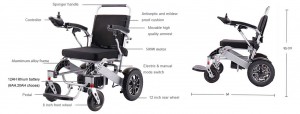What are the regulatory requirements of the US FDA for electric wheelchairs?
Introduction: Regulatory background of electric wheelchairs in the US market
As the global population ages, the market demand for electric wheelchairs as an important medical assistive device continues to grow. As one of the world’s largest medical device markets, the United States has very strict regulatory requirements for electric wheelchairs. The US Food and Drug Administration (FDA) implements comprehensive supervision on the production and sale of electric wheelchairs to ensure the safety and effectiveness of the products. This article will analyze in detail the FDA’s regulatory requirements for electric wheelchairs to help manufacturers and exporters better understand and respond to these requirements.
1. FDA Classification and Regulation of Electric Wheelchairs
1. Classification of Electric Wheelchairs
Electric wheelchairs are classified as Class II medical devices by the FDA, which means that their safety needs to be verified through a specific regulatory path.
2. Regulatory Path
The FDA provides two main regulatory paths for Class II medical devices:
510(k) certification: This is the most common path, requiring manufacturers to prove that their products are equivalent to legal products already on the market.
De Novo path: Applicable to new medical devices that do not have legal equivalent products.
2. FDA 510(k) certification process for electric wheelchairs
1. Determine product classification
Manufacturers need to confirm that electric wheelchairs are Class II medical devices according to FDA classification rules.
2. Prepare 510(k) documents
510(k) documents are key documents to prove to FDA that electric wheelchairs are equivalent to legal products on the market, and usually include the following:
Product description
Technical specifications
Performance test data
Clinical study report (if applicable)
Comparative analysis with comparative products.
3. Submit 510(k) documents
Manufacturers need to submit the prepared documents to FDA, and FDA will review the documents. If the documents are incomplete or do not meet the requirements, FDA may request additional information or conduct an interview.
4. Premarket notification (PMN)
In some cases, manufacturers need to submit a premarket notification (PMN) to FDA to inform the market launch plan of new medical devices.
5. On-site audit
FDA may conduct on-site audits of manufacturers’ production facilities to ensure that their quality management systems meet the requirements.
6. Obtain 510(k) approval
After review and audit, the FDA will approve the 510(k) and issue a 510(k) number.
7. Registration and listing
Manufacturers need to register their medical devices in the United States and list their products in the medical device catalog.
III. Technical and safety requirements for electric wheelchairs
1. Safety standards
Electrical wheelchairs must comply with safety standards established by the FDA, including but not limited to:
Battery safety
Electrical safety
Mechanical safety.
2. Test reports
Manufacturers need to submit test reports that meet FDA approval, including:
ISO 7176 system testing
Biocompatibility testing
Electromagnetic compatibility testing.
3. Quality system
Manufacturers must establish a quality system (QSR 820) that meets FDA requirements to ensure product quality and safety.
IV. Precautions for exporting to the United States
1. Label requirements
The labels and instructions of electric wheelchairs must comply with the requirements of US regulations and standards, including UDI (Unique Device Identifier) labels.
2. Battery capacity restrictions
International logistics has strict restrictions on the mailing of batteries, and the battery capacity of electric wheelchairs must not exceed the specified value.
3. Packaging and transportation
The packaging of electric wheelchairs should comply with international transportation standards to ensure that they are not damaged during transportation.
V. Conclusion and Recommendations
FDA’s regulatory requirements for electric wheelchairs are complex and strict. Manufacturers and exporters need to fully understand and strictly comply with these requirements to ensure that their products can enter the US market smoothly. By obtaining FDA 510(k) certification, not only can the market competitiveness of products be improved, but also the health and safety of consumers can be guaranteed.
Post time: Apr-07-2025


